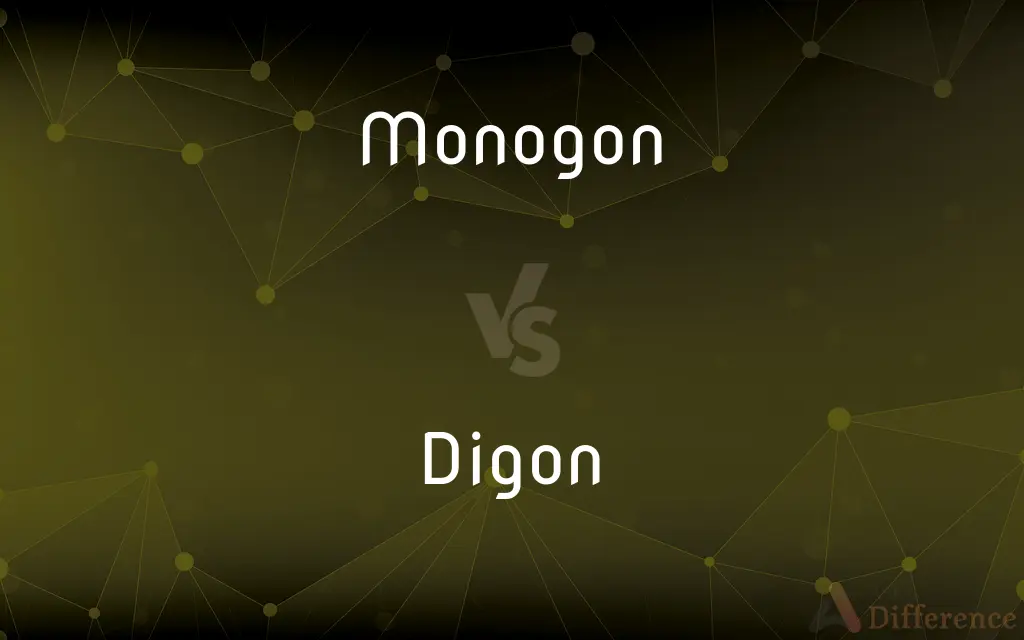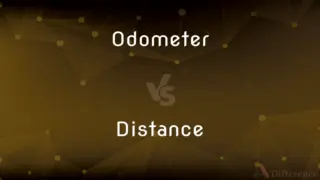Monogon vs. Digon — What's the Difference?
By Maham Liaqat & Fiza Rafique — Updated on April 26, 2024
A monogon, a theoretical polygon with one side and one vertex, is considered an abstraction in geometry, whereas a digon, with two sides and two vertices, can exist under non-Euclidean geometry but not in a Euclidean setting.

Difference Between Monogon and Digon
Table of Contents
ADVERTISEMENT
Key Differences
The concept of a monogon revolves around having a single edge and a single vertex, making it a theoretical construct in traditional Euclidean geometry where it doesn't manifest as a practical shape. Conversely, a digon, consisting of two edges and two vertices, is similarly theoretical in Euclidean contexts but can exist on spherical surfaces.
Monogons challenge conventional geometric definitions and are often used in theoretical discussions to explore the boundaries of mathematical principles. On the other hand, digons in non-Euclidean geometry, particularly spherical geometry, illustrate how altering geometric rules can yield valid but different polygons.
In terms of representation, a monogon might be depicted as a looped line back to its origin point, not forming any internal area. Meanwhile, a digon in spherical geometry could be visualized as two points on a sphere connected by two arcs, each representing a side, and enclosing an area.
While monogons do not have practical applications due to their theoretical nature, digons find relevance in studies involving spherical geometries where their properties help in understanding spatial relationships on curved surfaces.
Furthermore, the study of these shapes contributes to fields like topology and complex geometries, where concepts like a monogon and digon are essential for theoretical underpinnings that challenge or extend traditional notions of shape and space.
ADVERTISEMENT
Comparison Chart
Sides
1
2
Vertices
1
2
Euclidean Geometry
Theoretical/not practically existing
Theoretical/not existing
Non-Euclidean Geometry
Theoretical/not existing
Exists, particularly in spherical geometry
Practical Applications
None due to theoretical nature
Used in theoretical studies of spherical geometries
Compare with Definitions
Monogon
A polygon with only one side and one vertex.
A monogon is a conceptual tool in geometry, serving more theoretical than practical purposes.
Digon
A polygon with two sides and two vertices, existing in non-Euclidean geometries.
A digon can be visualized on a sphere where its sides curve outward.
Monogon
A theoretical shape in Euclidean geometry.
In Euclidean space, a monogon does not physically manifest as it defies practical construction.
Digon
A shape used to study spherical and hyperbolic geometries.
Digons are pivotal in discussions about the properties of shapes on curved surfaces.
Monogon
A simplification for certain mathematical models.
Monogons simplify some mathematical equations by reducing the variables to one.
Digon
A basic element in certain geometrical theories.
In spherical geometry, digons are used to explain how angles and sides behave differently than in Euclidean contexts.
Monogon
A geometric abstraction used in theoretical mathematics.
Monogons are often discussed in the context of abstract mathematical theories.
Digon
A theoretical construct in Euclidean geometry.
In a flat plane, a digon collapses into a line segment, making it non-existent.
Monogon
A conceptual example in topology.
Topologists use monogons to illustrate properties of space and boundaries.
Digon
A tool for understanding non-standard geometric spaces.
The study of digons helps mathematicians explore the limits of geometry beyond flat surfaces.
Monogon
In geometry, a monogon, also known as a henagon, is a polygon with one edge and one vertex. It has Schläfli symbol {1}.
Digon
In geometry, a digon is a polygon with two sides (edges) and two vertices. Its construction is degenerate in a Euclidean plane because either the two sides would coincide or one or both would have to be curved; however, it can be easily visualised in elliptic space.
Monogon
(geometry) A one-dimensional object comprising one vertex and one (not necessarily straight) edge both of whose ends are that vertex.
Digon
(geometry) A polygon having two edges and two vertices.
Monogon
(geometry) A two-dimensional object comprising one vertex, one edge both of whose ends are that vertex, and one face filling in the hollow formed by that edge.
Digon
(graph theory)
Monogon
(optics) A single-faceted reflector.
Digon
A pair of parallel undirected edges in a multigraph.
Digon
A pair of antiparallel edges in a directed graph.
Common Curiosities
How do digons manifest in spherical geometry?
In spherical geometry, a digon is formed by two maximum circles on the sphere that intersect at two antipodal points, creating two distinct sides and vertices.
Are monogons used in computer graphics or simulations?
Monogons are not typically used in computer graphics or simulations because they do not represent a practical shape or space but may appear in theoretical discussions or mathematical models.
What educational value do digons have?
Digons are valuable in educational contexts for illustrating the principles of spherical and hyperbolic geometries and showing the variability of polygonal properties in different geometrical settings.
Is a monogon theoretically possible in any form of geometry?
A monogon is theoretically possible in abstract geometrical discussions but does not exist practically in any standard geometrical settings, including non-Euclidean ones.
Can monogons be created through graphical representation?
Graphically, monogons can be represented as a single point where the end meets the start, or as a loop, but these are still theoretical constructs rather than true geometric shapes.
What is the significance of studying theoretical shapes like monogons and digons?
Studying theoretical shapes such as monogons and digons helps expand the understanding of geometric principles, exploring what is possible in different geometric settings beyond traditional Euclidean space.
Can monogons have angles?
In theoretical discussions, a monogon could be described as having an angle, but this is abstract and does not correspond to angles as understood in practical geometry.
What distinguishes a digon from a biangle?
A digon and a biangle refer to the same concept—a two-sided polygon—particularly in non-Euclidean geometries like spherical geometry.
What role do monogons play in abstract algebra or topology?
In abstract algebra and topology, monogons are used to explore the properties and behaviors of spaces and mathematical structures in a simplified form.
Why are monogons not recognized as standard geometric figures?
Monogons are not recognized as standard geometric figures because they lack practical construction and do not exhibit the properties typically associated with polygons, such as internal angles adding up to a certain sum.
What challenges do monogons present to conventional definitions of polygons?
Monogons challenge conventional definitions of polygons because they do not fit into the standard criteria of having multiple sides or vertices, thus pushing the boundaries of how polygons are traditionally understood and classified.
How are digons related to the concept of a lune in spherical geometry?
A digon in spherical geometry can be visualized as a specific type of lune, which is an area on a sphere bounded by two half-circles meeting at antipodal points.
Can a digon be considered a valid polygon in any branch of mathematics?
In non-Euclidean geometries, especially spherical geometry, digons are considered valid polygons with real properties and are studied as such.
Are there any practical applications for the concepts of monogons or digons in modern mathematics or physics?
While not practical for physical constructions, the concepts of monogons and digons are useful in theoretical mathematics and physics for exploring and illustrating complex ideas in topology and theoretical physics.
How does the concept of a digon help in understanding spherical geometry?
Digons serve as a fundamental example in spherical geometry to explain how traditional geometric rules change when applied to curved surfaces.
Share Your Discovery

Previous Comparison
Odometer vs. Distance
Next Comparison
Jiggle vs. WiggleAuthor Spotlight
Written by
Maham LiaqatCo-written by
Fiza RafiqueFiza Rafique is a skilled content writer at AskDifference.com, where she meticulously refines and enhances written pieces. Drawing from her vast editorial expertise, Fiza ensures clarity, accuracy, and precision in every article. Passionate about language, she continually seeks to elevate the quality of content for readers worldwide.
















































